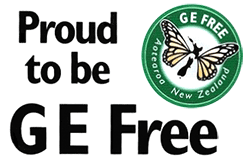The pressure to get rid of New Zealand's GE Free status is now as high as the pressure brought to bare on NZ when David Lange declared New Zealand a Nuclear Free nation.
There is no role for GE rye grass in New Zealand, and existing GE-free solutions are available now. The Otago report on "Clean Green" in New Zealand is flawed [1].
The release of the Report appears to be part of the government programme promoting a US/ New Zealand Free Trade deal where the benefits of protecting our GE Free status is to be traded off, along with other central pillars for New Zealand's future wellbeing.
The US has for a long time opposed any legislation that they think will be detrimental to the Free Trade partnership and entry of US goods [2]. The risk to New Zealand is the very bio-security and values that make us special.
"The Government is moving on an agenda of privatization of the total food supply by outside companies controlling patents. But it is forgetting its people and the consumers who buy NZ products," said Claire Bleakley President of GE FREE NZ.
"We have excellent high producing pastures that are proven safe for animals and are consumer acceptable. These pasture feeds are generating massive economic benefits for all of New Zealand, as Fonterra and Beef and Lamb exports show," said Claire Bleakley.
New Zealand has already completed robust research into fodder crops that reduce methane which FORST should continue to fund to get to the farm gate. These crops are already in New Zealand and include legumes and grasses such as trefoil, sulla clovers, lucerne and an assortment of grasses. Research has shown that they not only boost milk production but reduce methane emissions.[3][4]
"It is not from Organic Farmers that the horror stories of GE have come, but from conventional farmers and scientists'. Their observations and studies relate to the adverse effects of GE impacting on their farming operations. These are not a 'myth'" said Mrs. Bleakley.
"It is sad that the Government continues to put money into the failed but costly Genetic Engineering research instead of the alternatives that have real benefit to farmers and consumers" said Claire Bleakley.
The GE fodder crop offers no credible benefit to New Zealand: any hint of GE-fed animals has the potential to collapse the export market to Europe and Japan.
The argument for promoting GE feed does not stand up to scrutiny. Grass fed animals already have more Omega fatty acids and Vitamin E than grain fed animals. This is because omega-3 (linoleic and linolenic acid) fatty acids and Vitamin E are formed in the green leaves (specifically the chloroplasts) of plants. Sixty percent of the fat content of grass is a type of omega-3 fatty acid called alpha-linolenic or LNA which is lost when animals are fed on grain. Comparisons of Vitamin E levels in meat from feedlot cattle given high doses of synthetic Vitamin E (1,000 IU per day) with other cattle raised on fresh pasture with no added supplements, found that vitamin E in grass fed cattle was almost twice as high as the meat from the feedlot cattle given the supplements [5].
Perennial rye, cocksfoot and tall fescue grasses are already identified as naturally containing high levels sugars and both saturated and unsaturated lipids fats [6]. Leys containing plantain and chicory with the mixed grasses and legumes can provide a balanced and healthy pasture for stock without the risks of GE crops.
References:
[1] GM myth should be laid to rest: researcher Radio NZ News,3/4/2011, http://www.radionz.co.nz/news/national/71959/gm-myth-should-be-laid-to-rest-researcher
[2]Sabotage and subterfuge: public relations, democracy and genetic engineering in New Zealand (p. 331)
[3] Turner S-A, Waghorn GC, Woodward SL, Thomson NA Condensed tannins in birdsfoot trefoil (Lotus corniculatus) affect the detailed composition of milk from dairy cows Proceedings of the New Zealand Society of Animal Production, Volume 65, pp 283-289, Jan 2005
Woodward SL, Waghorn GC, Laboyrie PG Condensed tannins in birdsfoot trefoil (Lotus corniculatus) reduce methane emissions from dairy cows, Proceedings of the New Zealand Society of Animal Production, Volume 64, pp 160-164, Jan 2004
Wittenberg K.M. Enteric methane emissions and mitigation opportunities for Canadian cattle production systems. Department of Animal Science, University of Manitoba, Winnipeg, Manitoba R3T 2N2
�Energy lost as enteric methane emissions were 7.1 % of GEI for alfalfa-grass vs. 9.5 % of GEI for grass-only pastures. An 11 % increase for calf growth rates on the legume-grass pasture would serve as further incentive to consider legume incorporation as a mitigation strategy� (p6)
Ominski K and Wittenberg K.M (2004) Strategies For Reducing Enteric Methane Emissions In Forage-Based Beef Production Systems, University of Alberta, Edmonton, Alberta Canadian Society of Agronomy, Animal Science and Soil Science.
[4] Mountfort M., (2003) Methane mitigation Dairy Exporter; p56.
[5 Jo Johnson, The Health Benefits of Grass Farming "Why Grass-fed is Best!" http://www.americangrassfedbeef.com/grass-fed-natural-beef.asp
[6 Miri P s., Bittman s., Hunt D., Entz T and Yip B., 2006 Lipid content and fatty acid composition of grasses sampled on different dates through the early part of the growing season Can. J. Anim. Sci. 86: 279�290.
ENDS:
Claire Bleakley 027 348 6731 / 06-3089842
Jon Carapiet 021 050 7681 |


